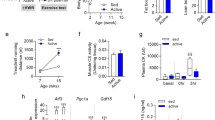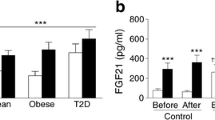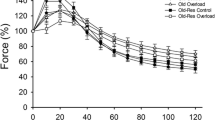Abstract
High-fat diet (HFD) increases fatty acid oxidation in skeletal muscles. We hypothesized that this leads to increased oxygen demand and thus to increased capillarization. We determined the effects of high-fat diet on capillarization and angiogenic factors in skeletal muscles of mice that were either active or sedentary. Fifty-eight C57BL/6 J mice were divided into four groups: low-fat diet sedentary (LFS), low-fat diet active (LFA), high-fat diet sedentary (HFS), and high-fat diet active (HFA). The mice in active groups were housed in cages with running wheels and the sedentary mice were housed in similar cages without running wheels. After 19 weeks HFS, LFA and HFA had higher capillary density and capillary-to-fiber-ratio in quadriceps femoris muscles than LFS. Capillarization was similar in HFS and HFA. To reveal possible mechanisms of HFD induced angiogenesis, we measured protein and mRNA levels of angiogenic factors VEGF-A, HIF-1α, PGC-1α and ERRα. VEGF-A protein levels were higher in muscles of HFS, LFA and HFA compared to LFS. However, no significant differences were observed between HFA and HFS. Protein levels of HIF-1α, PGC-1α, and ERRα were similar in all groups. However, the mRNA expression of HIF-1α and VEGF-A was up-regulated in capillaries but not in muscle fibers of HFS. The sedentary and active mice groups had similar mRNA expression levels of angiogenesis regulators studied. We conclude that high-fat feeding induces angiogenesis in skeletal muscle and up-regulates the gene expression of HIF-1α and VEGF-A in capillaries.



Similar content being viewed by others
Abbreviations
- BSA:
-
Bovine serum albumin
- cDNA:
-
Complementary DNA
- CSA:
-
Cross sectional area
- DTT:
-
Dithiothreitol
- ECL:
-
Enhanced chemiluminescence
- EDTA:
-
Ethylenediaminetetraacetic acid
- ERRα:
-
Estrogen-related receptor alpha
- FFA:
-
Free fatty acid
- GAPDH:
-
Glyceraldehyde 3-phosphate dehydrogenase
- HFD:
-
High-fat diet
- HFA:
-
High-fat active
- HFS:
-
High-fat sedentary
- HIF-1α:
-
Hypoxia-inducible factor 1, alpha subunit
- HIF-1β:
-
Hypoxia-inducible factor 1, beta subunit
- HOMA-IR:
-
Homeostatic model assessment of insulin resistance
- LCM:
-
Laser capture microdissection
- LFD:
-
Low-fat diet
- LFA:
-
Low-fat active
- LFS:
-
Low-fat sedentary
- MQF:
-
Musculus quadriceps femoris
- PBS:
-
Phosphate buffered saline
- PCR:
-
Polymerase chain reaction
- PGC-1α:
-
Peroxisome proliferator-activated receptor gamma coactivator 1-alpha
- PMSF:
-
Phenylmethylsulfonyl fluoride
- PVDF:
-
Polyvinylidene difluoride
- SDS:
-
Sodium dodecyl sulfate
- SDS-PAGE:
-
Sodium dodecyl sulfate polyacrylamide gel electrophoresis
- TBS-T:
-
Tris-buffered saline + Tween 20
- Tris–HCl:
-
Tris(hydroxymethyl)aminomethane-hydrogen chloride
- VEGF-A:
-
Vascular endothelial growth factor A
References
Hoppeler H, Luthi P, Claassen H, Weibel ER, Howald H (1973) The ultrastructure of the normal human skeletal muscle. A morphometric analysis on untrained men, women and well-trained orienteers. Pflugers Arch 344:217–232
Svedenhag J, Henriksson J, Juhlin-Dannfelt A (1984) Beta-adrenergic blockade and training in human subjects: effects on muscle metabolic capacity. Am J Physiol 247:E305–E311
Fitzsimons DP, Diffee GM, Herrick RE, Baldwin KM (1990) Effects of endurance exercise on isomyosin patterns in fast- and slow-twitch skeletal muscles. J Appl Physiol 68:1950–1955
Hancock CR, Han DH, Chen M, Terada S, Yasuda T, Wright DC, Holloszy JO (2008) High-fat diets cause insulin resistance despite an increase in muscle mitochondria. Proc Natl Acad Sci USA 105:7815–7820
Burcelin R, Crivelli V, Dacosta A, Roy-Tirelli A, Thorens B (2002) Heterogeneous metabolic adaptation of C57BL/6 J mice to high-fat diet. Am J Physiol Endocrinol Metab 282:E834–E842
Sparks LM, Xie H, Koza RA, Mynatt R, Hulver MW, Bray GA, Smith SR (2005) A high-fat diet coordinately downregulates genes required for mitochondrial oxidative phosphorylation in skeletal muscle. Diabetes 54:1926–1933
Crunkhorn S, Dearie F, Mantzoros C, Gami H, da Silva WS, Espinoza D, Faucette R, Barry K, Bianco AC, Patti ME (2007) Peroxisome proliferator activator receptor gamma coactivator-1 expression is reduced in obesity: potential pathogenic role of saturated fatty acids and p38 mitogen-activated protein kinase activation. J Biol Chem 282:15439–15450
Koves TR, Li P, An J, Akimoto T, Slentz D, Ilkayeva O, Dohm GL, Yan Z, Newgard CB, Muoio DM (2005) Peroxisome proliferator-activated receptor-gamma co-activator 1alpha-mediated metabolic remodeling of skeletal myocytes mimics exercise training and reverses lipid-induced mitochondrial inefficiency. J Biol Chem 280:33588–33598
Miller WC, Bryce GR, Conlee RK (1984) Adaptations to a high-fat diet that increase exercise endurance in male rats. J Appl Physiol 56:78–83
Nemeth PM, Rosser BW, Choksi RM, Norris BJ, Baker KM (1992) Metabolic response to a high-fat diet in neonatal and adult rat muscle. Am J Physiol 262:C282–C286
Simi B, Sempore B, Mayet MH, Favier RJ (1991) Additive effects of training and high-fat diet on energy metabolism during exercise. J Appl Physiol 71:197–203
Garcia-Roves P, Huss JM, Han DH, Hancock CR, Iglesias-Gutierrez E, Chen M, Holloszy JO (2007) Raising plasma fatty acid concentration induces increased biogenesis of mitochondria in skeletal muscle. Proc Natl Acad Sci USA 104:10709–10713
Turner N, Bruce CR, Beale SM, Hoehn KL, So T, Rolph MS, Cooney GJ (2007) Excess lipid availability increases mitochondrial fatty acid oxidative capacity in muscle: evidence against a role for reduced fatty acid oxidation in lipid-induced insulin resistance in rodents. Diabetes 56:2085–2092
O’Hagan KA, Cocchiglia S, Zhdanov AV, Tambuwala MM, Cummins EP, Monfared M, Agbor TA, Garvey JF, Papkovsky DB, Taylor CT, Allan BB (2009) PGC-1alpha is coupled to HIF-1alpha-dependent gene expression by increasing mitochondrial oxygen consumption in skeletal muscle cells. Proc Natl Acad Sci USA 106:2188–2193
McArdle WD, Katch FI, Katch VL (2001) Exercise physiology. Lippincott, Williams and Wilkins, Philadelphia, PA
Li Y, Hazarika S, Xie D, Pippen AM, Kontos CD, Annex BH (2007) In mice with type 2 diabetes, a vascular endothelial growth factor (VEGF)-activating transcription factor modulates VEGF signaling and induces therapeutic angiogenesis after hindlimb ischemia. Diabetes 56:656–665
Roudier E, Chapados N, Decary S, Gineste C, Le Bel C, Lavoie JM, Bergeron R, Birot O (2009) Angiomotin p80/p130 ratio: a new indicator of exercise-induced angiogenic activity in skeletal muscles from obese and non-obese rats? J Physiol 587:4105–4119
Booth FW, Laye MJ (2009) Lack of adequate appreciation of physical exercise’s complexities can pre-empt appropriate design and interpretation in scientific discovery. J Physiol 587:5527–5539
Matthews DR, Hosker JP, Rudenski AS, Naylor BA, Treacher DF, Turner RC (1985) Homeostasis model assessment: insulin resistance and beta-cell function from fasting plasma glucose and insulin concentrations in man. Diabetologia 28:412–419
Milkiewicz M, Haas TL (2005) Effect of mechanical stretch on HIF-1{alpha} and MMP-2 expression in capillaries isolated from overloaded skeletal muscles: laser capture microdissection study. Am J Physiol Heart Circ Physiol 289:H1315–H1320
Mahoney DJ, Carey K, Fu MH, Snow R, Cameron-Smith D, Parise G, Tarnopolsky MA (2004) Real-time RT-PCR analysis of housekeeping genes in human skeletal muscle following acute exercise. Physiol Genomics 18:226–231
Jemiolo B, Trappe S (2004) Single muscle fiber gene expression in human skeletal muscle: validation of internal control with exercise. Biochem Biophys Res Commun 320:1043–1050
Lundby C, Nordsborg N, Kusuhara K, Kristensen KM, Neufer PD, Pilegaard H (2005) Gene expression in human skeletal muscle: alternative normalization method and effect of repeated biopsies. Eur J Appl Physiol 95:351–360
Hulmi JJ, Silvennoinen M, Lehti M, Kivela R, Kainulainen H (2012) Altered REDD1, myostatin, and Akt/mTOR/FoxO/MAPK signaling in streptozotocin-induced diabetic muscle atrophy. Am J Physiol Endocrinol Metab 302:E307–E315
Hulmi JJ, Tannerstedt J, Selanne H, Kainulainen H, Kovanen V, Mero AA (2009) Resistance exercise with whey protein ingestion affects mTOR signaling pathway and myostatin in men. J Appl Physiol 106:1720–1729
Rinnankoski-Tuikka R, Silvennoinen M, Torvinen S, Hulmi JJ, Lehti M, Kivela R, Reunanen H, Kainulainen H (2012) Effects of high-fat diet and physical activity on pyruvate dehydrogenase kinase-4 in mouse skeletal muscle. Nutr Metab (Lond) 9:53
Waters RE, Rotevatn S, Li P, Annex BH, Yan Z (2004) Voluntary running induces fiber type-specific angiogenesis in mouse skeletal muscle. Am J Physiol Cell Physiol 287:C1342–C1348
Chinsomboon J, Ruas J, Gupta RK, Thom R, Shoag J, Rowe GC, Sawada N, Raghuram S, Arany Z (2009) The transcriptional coactivator PGC-1alpha mediates exercise-induced angiogenesis in skeletal muscle. Proc Natl Acad Sci USA 106:21401–21406
Costa RR, Villela NR, Souza MG, Boa BC, Cyrino FZ, Silva SV, Lisboa PC, Moura EG, Barja-Fidalgo TC, Bouskela E (2011) High fat diet induces central obesity, insulin resistance and microvascular dysfunction in hamsters. Microvasc Res 82:416–422
Staron RS, Hagerman FC, Hikida RS, Murray TF, Hostler DP, Crill MT, Ragg KE, Toma K (2000) Fiber type composition of the vastus lateralis muscle of young men and women. J Histochem Cytochem 48:623–629
Hamalainen N, Pette D (1993) The histochemical profiles of fast fiber types IIB, IID, and IIA in skeletal muscles of mouse, rat, and rabbit. J Histochem Cytochem 41:733–743
Ellis CG, Goldman D, Hanson M, Stephenson AH, Milkovich S, Benlamri A, Ellsworth ML, Sprague RS (2010) Defects in oxygen supply to skeletal muscle of prediabetic ZDF rats. Am J Physiol Heart Circ Physiol 298:H1661–H1670
Egginton S, Badr I, Williams J, Hauton D, Baan GC, Jaspers RT (2011) Physiological angiogenesis is a graded, not threshold, response. J Physiol 589:195–206
Carmeliet P, Jain RK (2011) Molecular mechanisms and clinical applications of angiogenesis. Nature 473:298–307
Semenza GL (2001) HIF-1, O(2), and the 3 PHDs: how animal cells signal hypoxia to the nucleus. Cell 107:1–3
Huang LE, Arany Z, Livingston DM, Bunn HF (1996) Activation of hypoxia-inducible transcription factor depends primarily upon redox-sensitive stabilization of its alpha subunit. J Biol Chem 271:32253–32259
Milkiewicz M, Doyle JL, Fudalewski T, Ispanovic E, Aghasi M, Haas TL (2007) HIF-1alpha and HIF-2alpha play a central role in stretch-induced but not shear-stress-induced angiogenesis in rat skeletal muscle. J Physiol 583:753–766
Bradley RL, Jeon JY, Liu FF, Maratos-Flier E (2008) Voluntary exercise improves insulin sensitivity and adipose tissue inflammation in diet-induced obese mice. Am J Physiol Endocrinol Metab 295:E586–E594
Thomas DM, Bouchard C, Church T, Slentz C, Kraus WE, Redman LM, Martin CK, Silva AM, Vossen M, Westerterp K, Heymsfield SB (2012) Why do individuals not lose more weight from an exercise intervention at a defined dose?. An energy balance analysis, Obes Rev 13:835–847
Berra E, Roux D, Richard DE, Pouyssegur J (2001) Hypoxia-inducible factor-1 alpha (HIF-1 alpha) escapes O(2)-driven proteasomal degradation irrespective of its subcellular localization: nucleus or cytoplasm. EMBO Rep 2:615–620
Acknowledgments
The authors would like to thank Aila Ollikainen and Lauri Stenroth for their skillful help in the laboratory. The study was financially supported by the Finnish Ministry of Education and Culture (50/627/2010) and the Academy of Finland (125209). Support from the National Doctoral Programme of Musculoskeletal Disorders and Biomaterials (TBDP) is also acknowledged.
Author information
Authors and Affiliations
Corresponding author
Additional information
Mika Silvennoinen, Rita Rinnankoski-Tuikka contributed equally to this work.
Rights and permissions
About this article
Cite this article
Silvennoinen, M., Rinnankoski-Tuikka, R., Vuento, M. et al. High-fat feeding induces angiogenesis in skeletal muscle and activates angiogenic pathways in capillaries. Angiogenesis 16, 297–307 (2013). https://doi.org/10.1007/s10456-012-9315-8
Received:
Accepted:
Published:
Issue Date:
DOI: https://doi.org/10.1007/s10456-012-9315-8




